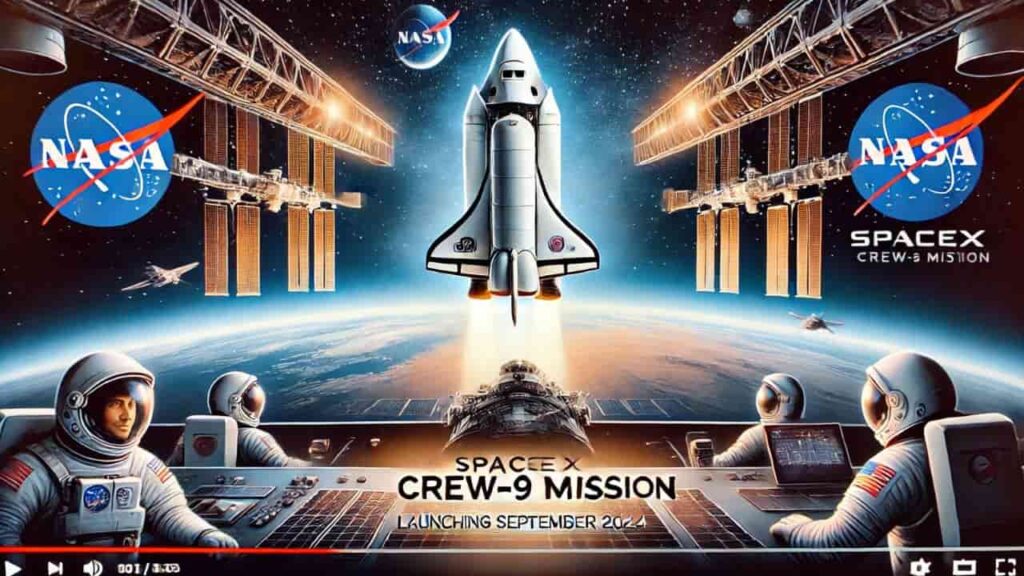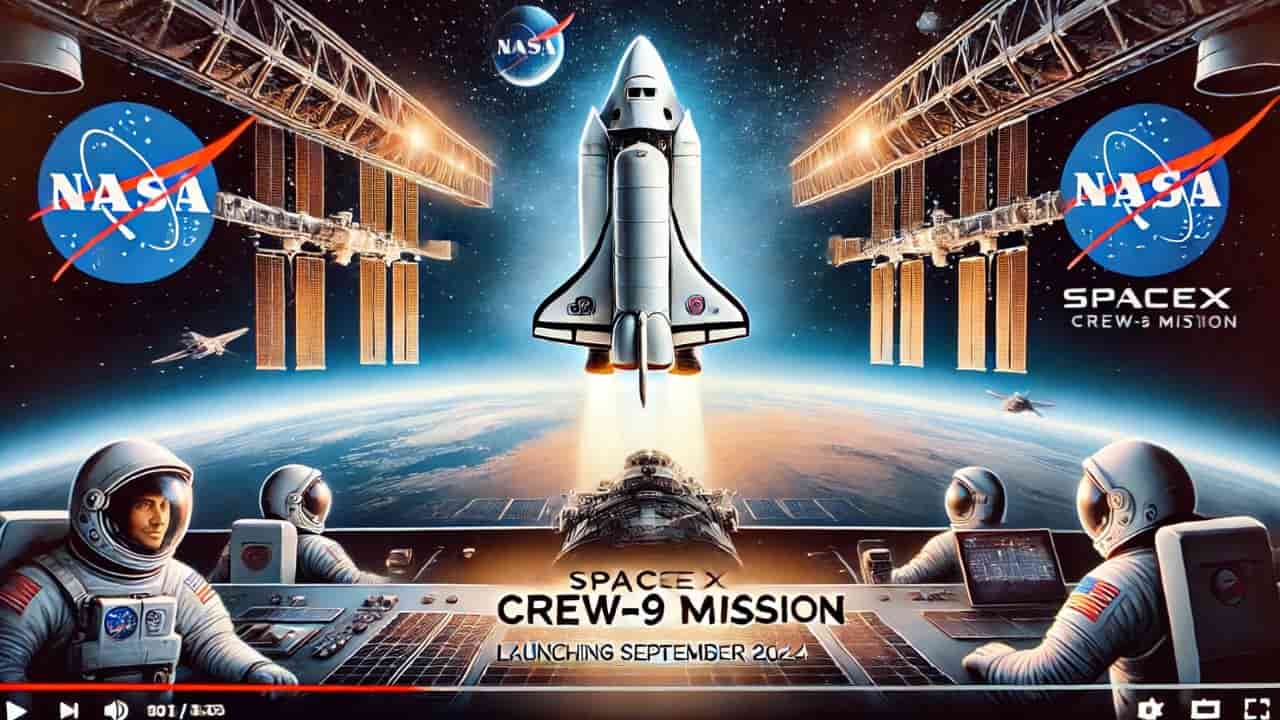NASA SpaceX Crew-9, NASA Crew-9 mission, SpaceX September 2024 launch, Nick Hague SpaceX mission, Aleksandr Gorbunov Crew-9, NASA SpaceX Dragon, NASA astronauts September launch, International Space Station mission, NASA Commercial Crew Program, Expedition 72 ISS
Explore the upcoming NASA SpaceX Crew-9 mission scheduled for September 2024. Learn about the updated astronaut lineup featuring Nick Hague and Aleksandr Gorbunov, their roles in the mission, and the significance of this launch for NASA’s Commercial Crew Program and the International Space Station.

NASA’s SpaceX Crew-9 Mission: Changes and Challenges Ahead of the September Launch
NASA and SpaceX are preparing for the highly anticipated Crew-9 mission to the International Space Station (ISS), now slated for no earlier than Tuesday, September 24, 2024. The mission, part of the ongoing collaboration between NASA and SpaceX under NASA’s Commercial Crew Program, is pivotal for maintaining the continuous human presence aboard the ISS, which has now entered its 24th year. However, recent adjustments in the crew lineup have reshaped the mission, highlighting the dynamic nature of space exploration and the flexibility required to meet new challenges.
Updated Crew for SpaceX Crew-9
Initially, NASA astronauts Zena Cardman and Stephanie Wilson were announced as part of the Crew-9 mission, alongside NASA astronaut Nick Hague and Roscosmos cosmonaut Aleksandr Gorbunov. However, in a significant crew adjustment, Cardman and Wilson have been reassigned to future missions, leaving Hague and Gorbunov as the two sole astronauts for the September 2024 launch.
Nick Hague, an experienced NASA astronaut, will command the mission, while Aleksandr Gorbunov, a Roscosmos cosmonaut, will serve as the mission specialist. The two-man crew will fly aboard SpaceX’s Dragon spacecraft to the ISS, taking over critical roles in research, maintenance, and ensuring the continued safe operation of the space station.
Why the Changes?
NASA’s decision to reduce the crew size from four to two members is rooted in logistical planning and the need to balance crew assignments across multiple missions. The downsizing comes after NASA’s Boeing Crew Flight Test was successfully completed as an uncrewed mission earlier this year. With the Starliner spacecraft still in the evaluation phase, NASA opted to fly Hague and Gorbunov to the ISS with two unoccupied seats aboard the Dragon capsule.
The decision was made by NASA’s chief astronaut, Joe Acaba, at the Johnson Space Center in Houston. He explained that assigning Nick Hague, an astronaut with extensive spaceflight experience, to command the mission was crucial for maintaining the operational safety of the space station. Hague’s previous missions, which include a total of 203 days in space and a dramatic in-flight abort in 2018, make him a seasoned choice for such an important role. Meanwhile, Gorbunov’s expertise in spacecraft engineering and flight operations makes him a strong addition to the mission.
“While we’ve changed crew before for a variety of reasons, downsizing the crew for this flight was another tough decision,” Acaba said, emphasizing the challenges of maintaining a balanced crew, particularly with the integration of Roscosmos cosmonauts who are essential for managing Russian-built systems aboard the ISS.
Nick Hague’s Spaceflight Experience
Nick Hague’s inclusion in the Crew-9 mission marks his third launch to space, a testament to his extensive experience and resilience as an astronaut. Hague first flew in October 2018 aboard the Soyuz MS-10 spacecraft with Roscosmos cosmonaut Alexey Ovchinin. During this mission, a rocket booster failure resulted in a dramatic in-flight abort, forcing Hague and Ovchinin to execute a ballistic re-entry and make an emergency landing back on Earth. Despite the incident, Hague’s calm demeanor and extensive training helped ensure a safe return.
Five months later, in March 2019, Hague launched again, this time aboard Soyuz MS-12, joining the ISS crew for Expeditions 59 and 60. During his time aboard the ISS, Hague conducted three spacewalks, including upgrades to the station’s power systems and the installation of a docking adapter for future commercial spacecraft. Hague’s work contributed to the growing commercial partnerships that are now central to NASA’s plans for the ISS and beyond.
In addition to his work in space, Hague has also contributed significantly to the U.S. Space Force, where he served as the director of test and evaluation from 2020 to 2022. He returned to NASA in August 2022 and began working on the Boeing Starliner program before his current assignment to Crew-9.
Hague’s third mission will see him returning to the ISS, where he will continue his vital contributions to ongoing research and operations. As he prepares for the launch, Hague remains an active presence on social media, sharing updates and insights into his training with followers on platforms like X (formerly Twitter) and Instagram.
Aleksandr Gorbunov’s First Spaceflight
While Nick Hague is an experienced astronaut, Crew-9 will mark Aleksandr Gorbunov’s first trip to space. Born in Zheleznogorsk in Russia’s Kursk region, Gorbunov is an engineer by training, with qualifications in spacecraft and upper stages from the Moscow Aviation Institute. He also holds specialized skills in operating and repairing aircraft, helicopters, and aircraft engines, making him an invaluable asset to the mission.
Gorbunov’s journey to becoming a cosmonaut began in 2018 when he was selected by Roscosmos after working as an engineer for Rocket Space Corp. Energia, Russia’s leading spacecraft manufacturer. His work supporting cargo spacecraft launches from the Baikonur Cosmodrome, one of the world’s most important spaceports, prepared him for his upcoming role aboard the ISS.
Though this will be his first time in space, Gorbunov’s extensive technical expertise and training make him well-prepared to serve as a mission specialist. Once aboard the ISS, he will work alongside Hague and the other members of Expedition 72, including NASA astronaut Butch Wilmore and Roscosmos cosmonauts Alexey Ovchinin and Ivan Vagner.
Expedition 72 and Beyond
Once aboard the ISS, Hague and Gorbunov will join the existing crew of Expedition 72, which includes Butch Wilmore, Suni Williams, Don Pettit, Alexey Ovchinin, and Ivan Vagner. Together, they will conduct scientific research and maintenance activities that are essential to the continued operation of the space station.
One of the key goals of the ISS missions is to support long-term space exploration, providing valuable data on how humans live and work in space for extended periods. These insights are critical for future missions to the Moon, Mars, and beyond. Hague and Gorbunov will play vital roles in this research, conducting experiments in areas such as biology, physics, and materials science.
Crew-9 is expected to spend several months aboard the ISS, returning to Earth in February 2025. During their time aboard the space station, the crew will also conduct repairs and upgrades to ensure the ISS remains fully operational.
The Future of NASA’s Commercial Crew Program
The SpaceX Crew-9 mission is part of NASA’s broader Commercial Crew Program, which seeks to leverage private sector partnerships to support NASA’s space exploration goals. SpaceX has been a key player in this effort, providing reliable transportation to and from the ISS with its Dragon spacecraft. Crew-9 represents the ninth operational flight of SpaceX’s Crew Dragon under NASA’s Commercial Crew Program, which began in 2020.
The decision to reduce the Crew-9 team underscores NASA’s adaptability in managing its missions and crew assignments. With Cardman and Wilson reassigned to future flights, NASA remains committed to ensuring that all astronauts have opportunities to contribute to its ambitious space exploration goals. The agency has yet to announce specific details on when Cardman and Wilson will fly, but both astronauts expressed their support for Hague and Gorbunov in their current mission.
As NASA continues to work with SpaceX, Boeing, and other commercial partners, the success of missions like Crew-9 will be vital in maintaining the momentum of human space exploration. The ISS remains a cornerstone of NASA’s long-term strategy, serving as both a research laboratory and a proving ground for future missions to the Moon, Mars, and beyond.
Conclusion
NASA’s SpaceX Crew-9 mission represents another important step in the ongoing exploration of space. With Nick Hague and Aleksandr Gorbunov set to launch in September 2024, the mission highlights the adaptability and collaboration required for successful space exploration. Hague’s extensive experience and Gorbunov’s engineering expertise ensure that the crew is well-prepared for the challenges that lie ahead. As NASA continues to push the boundaries of human space exploration, Crew-9 will play a critical role in advancing our understanding of life in space and preparing for the future of space travel.
Read More
- NASA Astronaut Don Pettits Innovative Space Experiments A Journey of Discovery
- SpaceXs New Falcon 9 Booster Successfully Launches 22 Starlink Satellites Boosting Global Connectivity
- NASA and Northrop Grummans 21st Resupply Mission to ISS: Launch Details and Scientific Highlights
- NASAs Europa Clipper Mission Exploring Jupiters Icy Moon for Signs of Life










